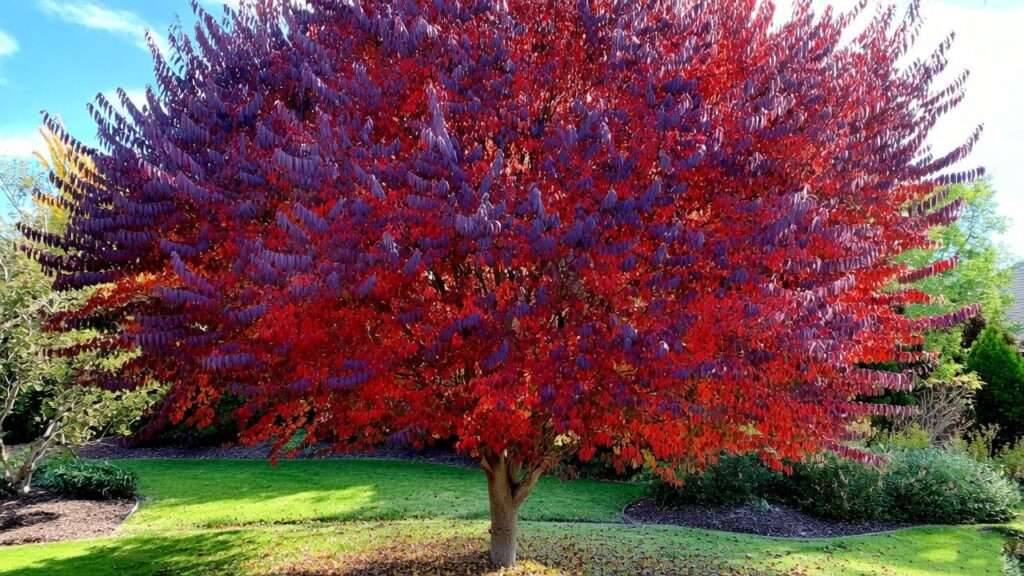Imagine your backyard ablaze with fiery red and deep purple hues, transforming your landscape into a breathtaking autumn masterpiece. The Raywood Ash Tree (Fraxinus angustifolia ‘Raywood’) delivers exactly that—a stunning, low-maintenance tree that captivates with its vibrant fall foliage. Whether you’re a homeowner, a landscaper, or a tree enthusiast, this guide is your roadmap to growing a healthy, thriving Raywood Ash. Backed by insights from certified arborists and decades of tree care expertise, we’ll cover everything from planting to pest control, ensuring your tree flourishes year-round. Ready to elevate your garden with this ornamental gem? Let’s dive in! 🌿
Why Choose a Raywood Ash Tree? 🌟
Unique Features of the Raywood Ash
The Raywood Ash, often called the “Claret Ash,” is a deciduous tree renowned for its dazzling fall display. Its fine-textured, narrow leaves turn from lush green to vibrant shades of red, burgundy, and purple, creating a show-stopping focal point. Growing 25-50 feet tall with a spread of 20-30 feet, it’s ideal for medium-sized yards. This tree thrives in USDA Hardiness Zones 5-8, adapting well to various climates, from cool temperate regions to warmer areas. Its fast growth rate—1-2 feet per year—makes it a favorite for those seeking quick landscape impact.
Benefits for Homeowners and Landscapers
Why plant a Raywood Ash? It’s low-maintenance, requiring minimal care once established, perfect for busy gardeners. Its dense canopy provides ample shade, cooling your outdoor space in summer. Unlike some ash varieties, the Raywood is less prone to invasive pests like the emerald ash borer, though vigilance is still key. Landscapers love its versatility—it fits urban settings, suburban lawns, or even large containers. Plus, its striking autumn colors boost curb appeal, potentially increasing property value. 🌄
Planting Your Raywood Ash Tree: Getting Started Right 🌱
Choosing the Perfect Location
To ensure your Raywood Ash thrives, site selection is critical. This tree loves full sun, needing at least 6 hours of direct sunlight daily to maximize growth and fall color intensity. It prefers well-draining, loamy soil but tolerates clay or sandy soils with proper care. Test your soil’s drainage by digging a 12-inch hole, filling it with water, and ensuring it drains within a few hours. Space matters too—allow 20-30 feet for the tree’s mature spread to prevent overcrowding nearby plants or structures.
Best Time to Plant
Timing is everything for a strong start. Plant your Raywood Ash in spring or early fall to give roots time to establish before extreme weather. Spring planting suits colder climates (Zones 5-6), allowing roots to settle before winter. In warmer regions (Zones 7-8), early fall is ideal, as cooler temperatures reduce stress on young trees. Avoid planting during summer heatwaves or deep winter freezes, which can shock the tree.
Step-by-Step Planting Guide
- Dig the Hole: Make it twice as wide and the same depth as the root ball (e.g., 24 inches wide for a 12-inch root ball). This encourages root spread without burying the tree too deep.
- Prepare the Soil: Mix native soil with 20-30% organic compost to boost nutrients and improve drainage. Avoid heavy clay amendments that retain too much water.
- Plant the Tree: Place the tree in the hole, ensuring the root collar (where roots meet trunk) is level with the ground. Backfill with soil, tamping gently to eliminate air pockets.
- Water Thoroughly: Give the tree 1-2 gallons of water immediately after planting to settle the soil. Add a 2-inch layer of mulch (e.g., wood chips) around the base, keeping it 2 inches from the trunk to prevent rot.
- Stake if Needed: For windy areas, use two stakes to stabilize young trees for the first year, removing them once roots are established.

Essential Care Tips for a Thriving Raywood Ash 🌿
Watering Requirements
Proper watering is the foundation of a healthy Raywood Ash. For the first 1-2 years, water young trees deeply (1-2 inches per week), especially during dry spells. Use a soaker hose or drip irrigation to target the root zone, avoiding overhead watering that can promote fungal issues. Mature trees are drought-tolerant but benefit from occasional deep watering during prolonged droughts. Check soil moisture by digging 2-3 inches down—if it’s dry, water. Overwatering is a common mistake; watch for yellowing leaves or soggy soil, which signal root rot risk.
Fertilizing for Optimal Growth
Fertilizing supports vigorous growth and vibrant foliage. Apply a balanced, slow-release fertilizer (e.g., 10-10-10) in early spring before new growth begins. Spread 1-2 pounds per 100 square feet around the drip line (the area under the outer canopy). Alternatively, use organic compost or well-rotted manure for a natural nutrient boost. Avoid over-fertilizing, which can cause excessive leaf growth at the expense of root and branch strength. Soil testing every 2-3 years ensures nutrient levels and pH (ideal: 6.0-7.5) are optimal.
Pruning for Shape and Health ✂️
Pruning keeps your Raywood Ash healthy and shapely. The best time is late winter or early spring before buds break, as the tree is dormant and wounds heal quickly. Use clean, sharp tools to:
- Remove dead, damaged, or diseased branches.
- Thin out crowded areas to improve air circulation.
- Maintain a strong central leader (main trunk) for structural integrity.
Avoid heavy pruning, which stresses the tree, and never remove more than 25% of the canopy in one season. For large branches, use the three-cut method to prevent bark tearing.
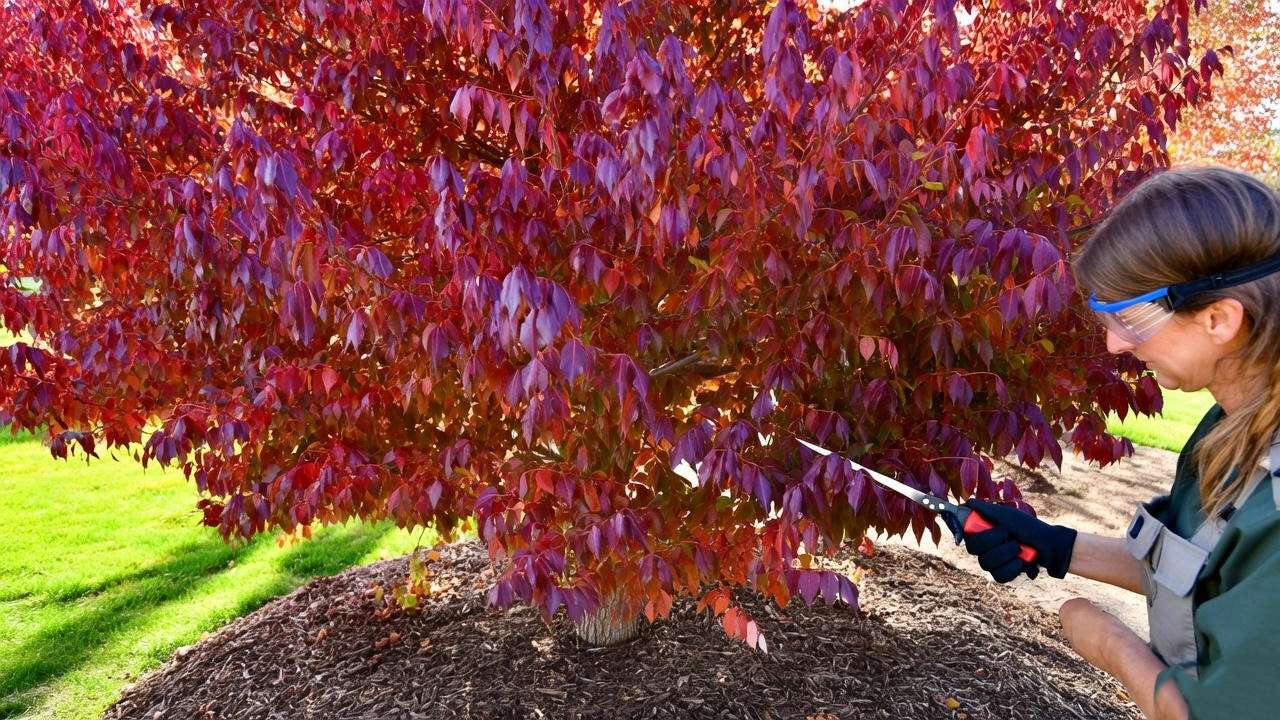
Mulching and Soil Care
Mulch is a game-changer for Raywood Ash care. Apply a 2-4 inch layer of organic mulch (e.g., bark, wood chips, or straw) around the base, extending to the drip line but keeping it 2 inches from the trunk. Mulch retains moisture, regulates soil temperature, and suppresses weeds, reducing competition for nutrients. Replenish annually in spring. Test soil pH and nutrients yearly—kits are available at garden centers or through university extension services. If pH is too acidic or alkaline, amend with lime or sulfur as needed.
Protecting Your Raywood Ash from Pests and Diseases 🐞
Common Pests
While Raywood Ash is relatively pest-resistant, it can face issues from aphids, scale insects, and, in some regions, ash borers. Aphids cause sticky leaves and curled foliage; scale appears as small, waxy bumps on branches. Check for ash borer signs like D-shaped exit holes or thinning canopies, though Raywood is less susceptible than other ashes. Control pests with:
- Organic Methods: Spray neem oil or insecticidal soap for aphids and scale.
- Chemical Options: Use targeted insecticides for severe infestations, following local regulations.
- Cultural Practices: Maintain tree vigor through proper watering and fertilizing to deter pests.
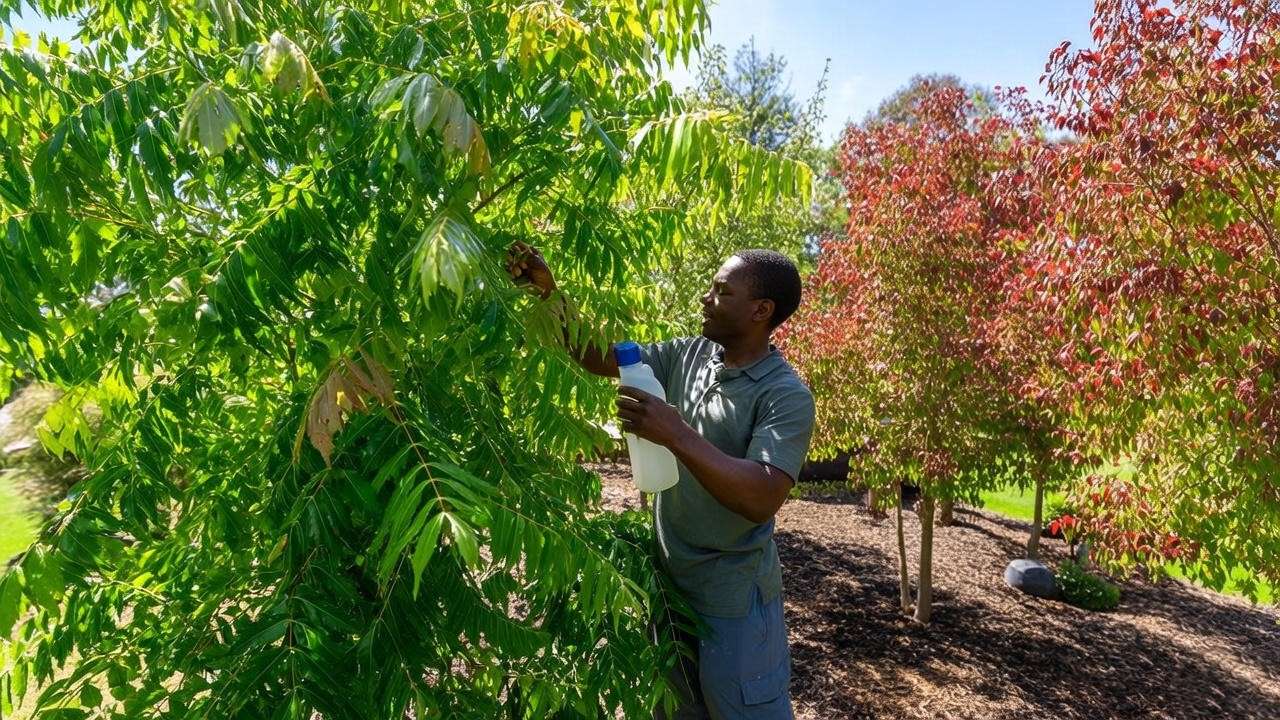
Diseases to Watch For
Two common diseases affect Raywood Ash: verticillium wilt and anthracnose. Verticillium wilt, caused by a soil-borne fungus, leads to wilting leaves, branch dieback, and dark streaks in the wood. Anthracnose causes dark, water-soaked spots on leaves, leading to premature leaf drop. Prevent diseases by:
- Ensuring good drainage to avoid root stress.
- Pruning affected branches and sterilizing tools to prevent spread.
- Removing fallen leaves to reduce fungal spores.
For severe cases, consult an arborist for fungicide recommendations or tree removal if wilt is advanced.
Expert Tip: Monitoring and Early Intervention
Regular inspections are your best defense. Check your tree monthly for signs of stress, such as yellowing leaves, unusual leaf drop, or bark damage. Early intervention—whether pruning, adjusting watering, or applying organic controls—can prevent minor issues from escalating. “Catching problems early is key,” says certified arborist Jane Thompson, with 20 years of experience in urban forestry. “A healthy Raywood Ash is a resilient one.” For complex issues, contact a local arborist certified by the International Society of Arboriculture (ISA).
Seasonal Care for Year-Round Beauty 🍂
Spring Care
Spring is a critical time to set your Raywood Ash up for success. As the tree emerges from dormancy, inspect it for winter damage, such as cracked branches or frostbitten tips. Apply a balanced fertilizer (e.g., 10-10-10) in early spring to fuel new growth, spreading it evenly around the drip line. Water young trees consistently, providing 1-2 inches per week to support budding and leaf development. For established trees, monitor soil moisture and water only if spring rains are insufficient. Remove any winter mulch to prevent excess moisture buildup, replacing it with a fresh 2-inch layer by mid-spring.
Summer Maintenance
Summer brings heat and potential stress, especially for young Raywood Ash trees. During heatwaves, water deeply every 7-10 days, ensuring the soil stays moist but not waterlogged. Use a soaker hose to deliver water directly to the root zone, minimizing evaporation. Check for pests like aphids or scale, which thrive in warm weather—spray with neem oil at the first sign of infestation. Mulch is your ally in summer, keeping roots cool and conserving water. Avoid pruning in summer, as it can stress the tree and attract pests to fresh cuts.
Fall Preparation
Fall is when the Raywood Ash truly shines, its leaves transforming into a fiery spectacle of red and purple. To enhance this display, ensure the tree gets ample sunlight and avoid over-fertilizing, which can dull fall colors. Water sparingly as the tree prepares for dormancy, reducing to once every 2-3 weeks unless the weather is unusually dry. Rake and remove fallen leaves to prevent fungal diseases like anthracnose from overwintering. For a stunning autumn showcase, consider photographing your tree or hosting a garden tour to highlight its beauty. 🌄
Winter Protection
Winter care focuses on protecting your Raywood Ash from cold and critters. For young trees (1-3 years old), wrap the trunk with burlap or tree wrap to prevent sunscald, where fluctuating temperatures cause bark cracking. In snowy regions, gently shake heavy snow off branches to avoid breakage. Mulch with a 3-4 inch layer to insulate roots, especially in colder climates (Zones 5-6). Rodents like voles can chew bark in winter—use a tree guard or hardware cloth around the base to deter them. Mature trees need little winter care but benefit from occasional inspections for storm damage.
Troubleshooting Common Raywood Ash Problems 🛠️
Yellowing Leaves
Yellow leaves often signal stress in a Raywood Ash. Common causes include:
- Nutrient Deficiency: Low nitrogen or iron can cause chlorosis. Test soil and apply a balanced fertilizer or chelated iron if needed.
- Overwatering: Soggy soil suffocates roots. Check drainage and reduce watering if the soil stays wet for days.
- Poor Drainage: Compacted or clay-heavy soil traps water. Aerate the soil or amend with sand and compost to improve drainage.
Solutions include adjusting watering schedules, testing soil annually, and ensuring proper sunlight exposure.
Weak or Sparse Growth
If your Raywood Ash has thin foliage or stunted growth, consider these culprits:
- Insufficient Sunlight: Less than 6 hours of sun weakens the tree. Relocate potted trees or thin nearby plants to increase light.
- Compacted Soil: Roots struggle in hard soil. Aerate around the drip line with a garden fork to loosen soil.
- Root Issues: Girdling roots or planting too deep can choke growth. Inspect the root collar and consult an arborist if roots are circling.
Address these by improving site conditions and ensuring proper care practices are followed.
Branch Dieback
Branch dieback—where tips or entire branches turn brown and die—can stem from:
- Disease: Verticillium wilt or anthracnose may be at play. Prune affected branches and improve cultural practices.
- Pest Damage: Ash borers or scale can weaken branches. Inspect for exit holes or sticky residue and treat accordingly.
- Environmental Stress: Drought or frost damage can cause dieback. Adjust watering and protect young trees in winter.
Prune dead branches using sterile tools and address underlying issues promptly to prevent further spread.
Enhancing Your Landscape with Raywood Ash 🌄
Companion Planting
The Raywood Ash pairs beautifully with companion plants that complement its aesthetic and needs. Choose low-growing shrubs or perennials that thrive in similar conditions (full sun, well-draining soil). Recommended options include:
- Lavender: Adds fragrance and purple hues, echoing the tree’s fall colors.
- Ornamental Grasses: Varieties like fountain grass provide texture and movement.
- Daylilies: Their bright blooms contrast with the tree’s foliage, creating a vibrant display.
Space companions at least 5-10 feet from the trunk to avoid root competition, and mulch to maintain a tidy look.
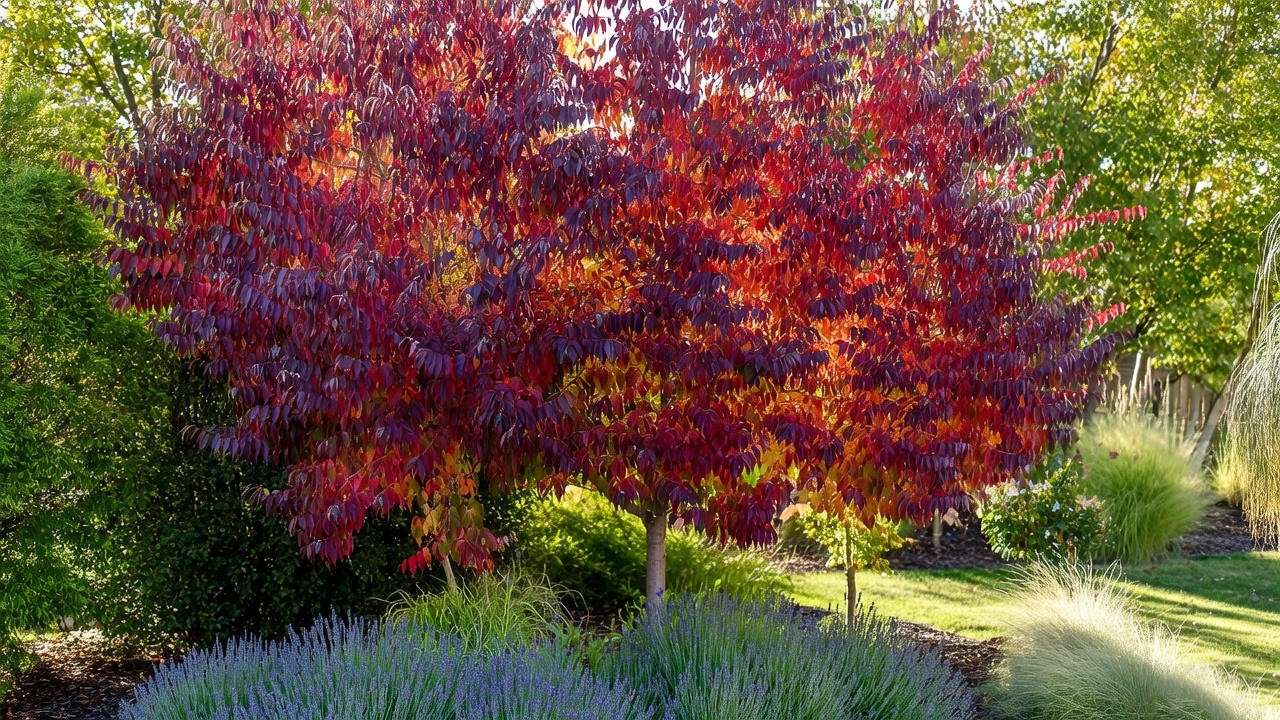
Design Ideas for Small and Large Yards
In small yards, use the Raywood Ash as a focal point, planting it centrally with a border of low perennials or groundcovers. Its upright growth suits narrow spaces, like urban courtyards. In larger landscapes, plant multiple Raywood Ashes in a row to create a shaded canopy or privacy screen. Pair with benches or a garden path to craft an inviting outdoor space. For modern designs, combine with sleek hardscaping elements like stone pavers. The tree’s moderate size makes it versatile for both compact and expansive settings.
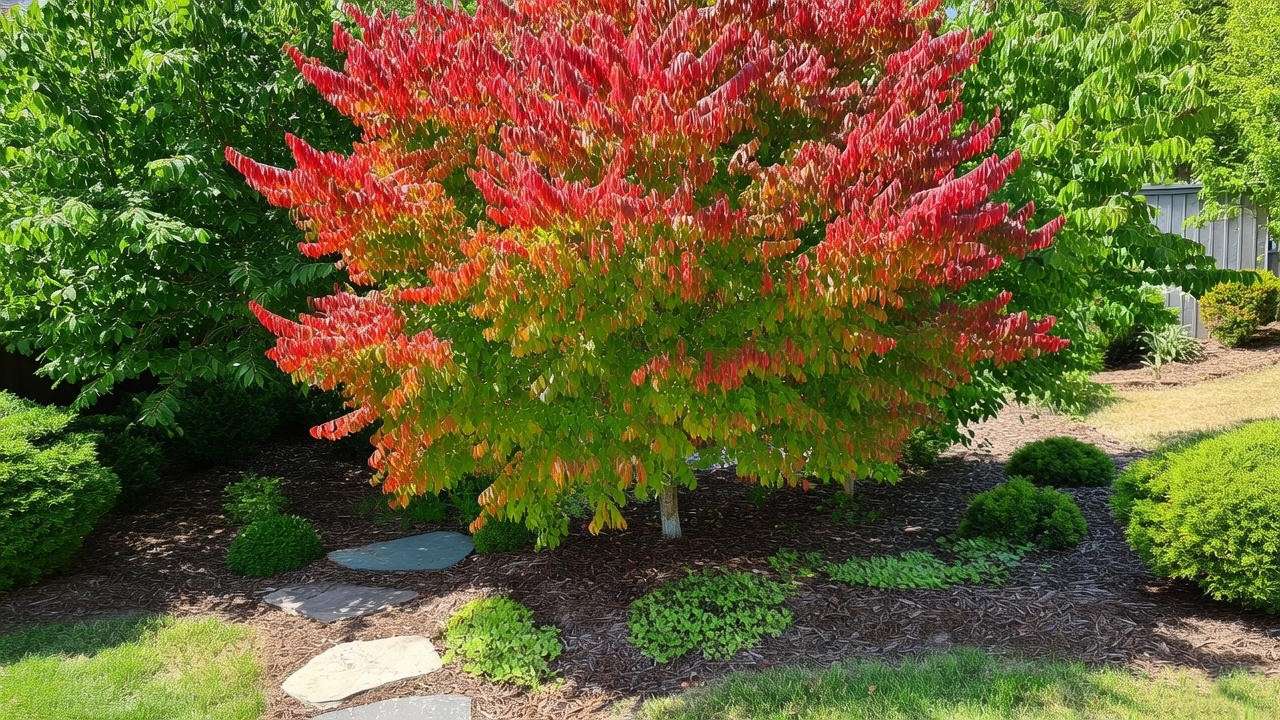
Eco-Friendly Benefits
Beyond beauty, the Raywood Ash offers environmental perks. Its dense canopy provides habitat for birds and pollinators, supporting local biodiversity. The tree sequesters carbon, improving air quality, and its shade reduces urban heat, cutting cooling costs. By choosing a Raywood Ash, you’re investing in a sustainable landscape that benefits both your property and the planet. 🌍
Expert Insights: What Arborists Say About Raywood Ash 🌳
Certified arborist Jane Thompson, with 20 years of experience, shares: “The Raywood Ash is a standout for its resilience and color. Its key to success is proper site selection—give it sun and good drainage, and it’ll reward you for years.” Landscaper Mark Rivera, who’s planted dozens of Raywood Ashes in urban settings, adds: “Clients love how quickly it transforms a space. Regular pruning and pest checks keep it thriving.” These insights underscore the importance of proactive care and expert guidance for long-term success.
FAQs About Raywood Ash Tree Care ❓
- How fast does a Raywood Ash grow? About 1-2 feet per year under optimal conditions, reaching maturity in 15-20 years.
- Is the Raywood Ash invasive? No, it’s non-invasive, but check local regulations as some areas restrict ash plantings due to pest concerns.
- Can it survive drought? Yes, mature trees are drought-tolerant, but young trees need consistent watering for 1-2 years.
- How do I prevent pests? Monitor regularly, use neem oil for minor infestations, and maintain tree health to boost resilience.
- Why isn’t my tree turning red in fall? Insufficient sunlight, nutrient deficiencies, or stress may be the cause. Ensure 6+ hours of sun and test soil nutrients.
Conclusion
The Raywood Ash Tree is a game-changer for any landscape, offering vibrant fall colors, low-maintenance care, and eco-friendly benefits. By choosing the right location, providing consistent water and nutrients, and staying vigilant against pests and diseases, you can grow a thriving tree that transforms your yard into an autumn masterpiece. Whether you’re a novice gardener or a seasoned landscaper, this guide equips you with expert-backed strategies to ensure success. Ready to plant your Raywood Ash? Share your journey in the comments or explore more tree care tips on our site! 🌳

